Niger

The Block
The distinctly patterned example of strip-weaving donated by H.E. Rakiatou Mayaki is the focus of the Niger block. Strip-weaving is a traditional textile art practiced not only in Niger, but throughout West Africa. Men of the village work on small looms to produce long, narrow strips of cloth, which are then sewn together into one large piece. The looms are portable and can be easily dismantled without ruining the weaving. This allows weavers to travel with their work or quickly pack it up when it rains or at the end of the work day. The technique uses warp floats, in which threads––woven into the cloth, but not part of the structural ground weave––add colour and textured geometric designs to the fabric.
An Agadez Cross hangs in the lower corner of the weaving. Crosses were traditionally worn only by men. They were created in specific designs to identify the wearer’s village. The four points of the cross were believed to symbolize the four corners of the world. These prized pieces were passed down from father to son in a ceremony that ended with the words, “My son, I give you the four corners of the world, because one cannot know where one will die.” Today the crosses are worn by both genders as neck adornments and as powerful talismans to protect against the ‘evil eye.’
Cultural Profile
A landlocked republic, formerly part of French West Africa, Niger is one of the hottest nations in the world. It is divided into three geographical zones: northern, central and southern. The northern zone, which covers more than half the country’s total area, is covered by the encroaching Sahara Desert. The central zone, known as the Sahel, is drought-stricken and lightly wooded. The Niger River runs through the fertile and forested southern zone. This unusual river has its source in Sierra Leone, just 250 km away from the sea, but it winds almost 4,000 km long through the Sahara in Mali, Niger, and Nigeria to reach the Gulf of Guinea. The river provides the only suitable area for livestock and agriculture in Niger.
The largest ethnic groups are the Hausa and Djerma-Songhai, farmers who live in the arable southern area of the country. The remainder of the population is comprised of nomadic or semi-nomadic groups, including the Tuareg, Fulani, Kanouri and Toubou. The official language is French; however several indigenous tongues, such as Hausa (one of the most wide-spread languages in sub-Saharan Africa) are also spoken.
One of the most remarkable cultural events in Niger is the Curée salée, the ‘salt cure’. At the end of the rainy season, tribes of Tuaregs and Wodaabe meet at the salt flats around In Gall to gather salt for their cattle, and to meet old acquaintances before leaving with their cattle for the dry season. It is the occasion for the Wodaabe to stage their Guerewol festival. While marriages are arranged and camel races are held during this festival, it is the yaake dances which are the most striking highlights of the festival. Beauty is central to Wodaabe identity, and during the yaake, men in traditional costume wearing yellow face paint dance for days to try to charm the women by showing their slender physique and the whiteness of their eyes and teeth. Women can then decide to take a husband, or even change husbands, as a Wodaabe woman can leave a man if she thinks she would be happier with someone else.
Niger is a land of skilled artisans known for leatherwork, silver jewelry, spinning, couvertures Djerma (large, bright strips of cotton sewn together), weaving, and brightly painted and embroidered garments and head cloths. The arts of the Tuareg include the making of leather saddles, swords and silver jewellery made by members of the Inadan caste, who are regarded with awe and distrust for their mastery of fire and metal work.
The Musée du Niger, in the capital city of Niamey, displays many traditional costumes, houses the famous Arbre du Ténéré (Ténéré’s Tree). At one time this was the Sahara’s last surviving tree. The tree had been one of most isolated on the planet, situated about 150 kilometres from its nearest neighbour with roots that reached the underground aquifer, 30 m below the ground. It was also the only tree to be shown on a map at a scale of 1:4,000,000.
People have been coming to Canada from Niger since 1976, often for political and economic reasons. Most settled in Québec because of their fluency in French, however overall numbers remain small. Associations, such as Le Rassemblement des Nigériens au Canada have been founded, promoting organized social activities and allowing Nigeriens to both preserve and share their culture with others.
Sponsor: Sandra Matthews
